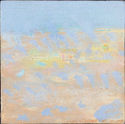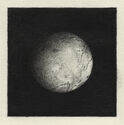
19th, 20th & 21st Century Fine Prints
707-546-7352 · fax 707-546-7924 · web: www.annexgalleries.com · email: artannex@aol.com
Paul Beattie Biography
Paul Beattie
1924–1988
Biography
Paul Beattie, painter and multidisciplinary artist, was born in Bay City, Michigan on 22 December 1924. At the age of twenty years old, after serving in the U.S. Navy, Beattie commenced his formal art training under Sakris Sarkisian at the Art School of the Detroit Society of Arts and Crafts (now the College for Creative Studies). Beattie married in 1947 before moving to the Lower East Side neighborhood of New York City. He continued his schooling under the GI Bill at the Brooklyn Museum Art School, studying with Rufino Tamayo and John Ferren. In 1950, he also took classes at the New School where his notable teacher was Adja Yunkers.
He began to show his paintings as early as 1947. He immersed himself in the New York Abstract Expressionist art scene and was exposed to the works of Hans Hoffmann, Franz Kline, Willem de Kooning, and Jackson Pollock. Beattie was included in the group exhibition 25 and Under at the Jacques Seligmann Galleries in 1949, and in 1950 he was included in Fourteen Under Thirty-six: An Exhibition of Paintings at the Studio 35 Gallery. There he showed with Elaine de Kooning, Grace Hartigan, Harry Jackson, Al Leslie, and Robert Richenburg. Beattie’s New York career culminated with a solo show in 1954 at the Hansa Gallery, which was founded in 1952 by a group of young artists from the Hans Hofmann School.
By 1955, Beattie had remarried, started a family and made the decision to move to San Francisco, California. He rented an apartment at 2322 Fillmore Street (aka “Painterland”), which was later made famous by Bruce Conner’s documentary film, “The White Rose.” In the highly experimental environment of these times, Beattie met many artists, including Jay De Feo, Wally Hedrick, Hassel Smith, and Hayward King. He got involved with light shows and filmmaking. He exhibited his art in several innovative galleries of the Beat era: The Six Gallery in San Francisco in 1954 and 1955, the East and West in San Francisco in 1955, the Semina Gallery in Larkspur in 1960-61, the New Mission Gallery in San Francisco in 1962, and the Batman Gallery of San Francisco in 1963 and 1964.
In 1963 the Beattie family moved to rural Sonoma County. During the next two decades, Beattie continued drawing and painting, while exhibiting in San Francisco and Los Angeles and working on his Masters of Art at UC Berkeley. From 1974 through 1978, he taught landscape composition and watercolor painting at the Santa Rosa Junior College. In 1975 he was invited to be part of the exhibition, Collage and Assemblage in Southern California at the Los Angeles Institute of Contemporary Art (LICA). Beattie had two shows at the San Francisco Museum of Modern Art which included Painting and Sculpture in California: The Modern Era in 1976, and Paul Beattie: Paintings and Drawings in 1980. His work was included in the museum’s celebratory The 50th Anniversary exhibition in 1984-85.
Beattie was profoundly influenced by quantum physics and the workings of the cosmos. He studied astronomy, cosmology, and physics and wrote a manuscript entitled “Art, Aesthetics and Astrophysics” (unpublished). In it he points out many similarities between art, physics, and the cosmos. In 1980 Thomas Albright, critic for the San Francisco Chronicle, wrote that Beattie’s paintings, "... explore cosmological phenomena, but they simultaneously focus more intently on the various points at which these phenomena intersect with art historical elements. Thus there are stains and patches of irregularly daubed and dappled color that suggest not only clouds and nebulas but the amorphous Impressionist surfaces of late Monet - there are lines and rods of color that imply not only the kinetic movement of magnetic fields, but the fractured geometry of early Mondrian.”
Beattie’s work is in the permanent collections of the Musée d’Art Moderne et Contemporain, Geneva, Switzerland; the Laguna Art Museum, Laguna Beach, California; the Oakland Museum of California; the San Francisco Museum of Modern Art, California; the San Jose Museum of Art, California; and the Doyle Collection, Santa Rosa Junior College, California.
Paul Beattie died on 20 June 1988 in Sonoma County, California. A retrospective of his work was held at the California Museum of Art in Santa Rosa.




